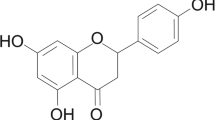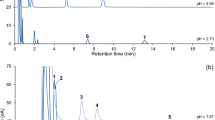Abstract
Validated LC-MS method for the direct quantitative analysis of galantamine (acetylcholinesterase inhibitor) was developed in rat cerebrospinal fluid and brain homogenate besides rat plasma, utilizing structurally close nalbuphine as an internal standard. After a simple protein precipitation step, samples are separated on 2-μm C18 column kept at 40 °C, using isocratic flow of 80% methanol in pH 9.5 ammonium formate buffer, and retention times were about 1.8 and 2.9 min for galantamine and nalbuphine, respectively. Mass detection with electrospray ionization (ESI) and positive polarity was able to detect 0.2 ng mL-1 galantamine using single ion monitoring mode (SIM) at m/z 288 for galantamine and m/z 358 for nalbuphine. The method showed linearity within the range of 0.5 – 300 ng mL-1. The proposed method was validated according to FDA guidelines. Trueness and precision showed acceptable values at all quality control levels, and recoveries were within 85.6 – 114.3% in all matrices at all runs and with relative standard deviations within 0.2 – 12.4%. The method was used to study in vivo brain uptake and pharmacokinetics of galantamine from brain homogenate and plasma samples following the administration of nasal galantamine-bound chitosan nanoparticles compared to oral and nasal galantamine solutions, in scopolamine-induced Alzheimer’s disease rat model.
Graphical abstract






Similar content being viewed by others
Data Availability
Not applicable.
Code availability
Not applicable.
Abbreviations
- GLA:
-
Galantamine
- NLB:
-
Nalbuphine
- CSF:
-
Cerebrospinal fluid
- GLA-NP:
-
Nasal galantamine-bound chitosan nanoparticles
- LLOQ:
-
Lower limit of quantification
- LQC:
-
Low-quality control
- MQC:
-
Medium-quality control
- HQC:
-
High-quality control
References
Thompson CA. FDA approves galantamine for Alzheimer's disease. Am J Health Syst Pharm. 2001;58(8):649.
Prvulovic D, Hampel H, Pantel J. Galantamine for Alzheimer's disease. Expert Opin Drug Metab Toxicol. 2010;6(3):345–54.
Farlow MR. Clinical pharmacokinetics of galantamine. Clin Pharmacokinet. 2003;42(15):1383–92.
Lane M, Carter D, Pescrille JD, Aracava Y, Fawcett WP, Basinger GW, et al. Oral pretreatment with galantamine effectively mitigates the acute toxicity of a supralethal dose of soman in cynomolgus monkeys posttreated with conventional antidotes. J Pharmacol Exp Ther. 2020;375(1):115–26.
Albuquerque EX, Pereira EFR, Aracava Y, Fawcett WP, Oliveira M, Randall WR, et al. Effective countermeasure against poisoning by organophosphorus insecticides and nerve agents. Proc Natl Acad Sci USA. 2006;103(35):13220–5.
Nicolson R, Craven-Thuss B, Smith J. A prospective, open-label trial of galantamine in autistic disorder. J Child Adolesc Psychopharmacol. 2006;16(5):621–9.
Naguib S, Bernardo-Colon A, Cencer C, Gandra N, Rex TS. Galantamine protects against synaptic, axonal, and vision deficits in experimental neurotrauma. Neurobiol Dis. 2020;134:104695.
Hanazawa T, Kamijo Y, Yoshizawa T, Fujita Y, Usui K, Haga Y. Acute cholinergic syndrome in a patient with Alzheimer's disease taking the prescribed dose of galantamine. Psychogeriatrics. 2018;18(5):434–5.
Birks JS. Cholinesterase inhibitors for Alzheimer's disease. Cochrane Database Syst Rev. 2006;(1):CD005593.
Ameen D, Michniak-Kohn B. Development and in vitro evaluation of pressure sensitive adhesive patch for the transdermal delivery of galantamine: effect of penetration enhancers and crystallization inhibition. Eur J Pharm Biopharm. 2019;139:262–71.
Woo FY, Basri M, Masoumi HR, Ahmad MB, Ismail M. Formulation optimization of galantamine hydrobromide loaded gel drug reservoirs in transdermal patch for Alzheimer's disease. Int J Nanomedicine. 2015;10:3879–86.
Katdare A, Khunt D, Thakkar S, Polaka SN, Misra M. Comparative evaluation of fish oil and butter oil in modulating delivery of galantamine hydrobromide to brain via intranasal route: pharmacokinetic and oxidative stress studies. Drug Deliv Transl Res. 2020;10(4):1136–46.
Sunena SSK, Mishra DN. Nose to brain delivery of galantamine loaded nanoparticles: in-vivo pharmacodynamic and biochemical study in mice. Curr Drug Deliv. 2019;16(1):51–8.
Leonard AK, Sileno AP, Brandt GC, Foerder CA, Quay SC, Costantino HR. In vitro formulation optimization of intranasal galantamine leading to enhanced bioavailability and reduced emetic response in vivo. Int J Pharm. 2007;335(1-2):138–46.
Gajbhiye KR, Gajbhiye V, Siddiqui IA, Pilla S, Soni V. Ascorbic acid tethered polymeric nanoparticles enable efficient brain delivery of galantamine: an in vitro-in vivo study. Sci Rep. 2017;7(1):11086.
Misra S, Chopra K, Sinha VR, Medhi B. Galantamine-loaded solid-lipid nanoparticles for enhanced brain delivery: preparation, characterization, in vitro and in vivo evaluations. Drug Deliv. 2016;23(4):1434–43.
Fornaguera C, Feiner-Gracia N, Caldero G, Garcia-Celma MJ, Solans C. Galantamine-loaded PLGA nanoparticles, from nano-emulsion templating, as novel advanced drug delivery systems to treat neurodegenerative diseases. Nanoscale. 2015;7(28):12076–84.
Mufamadi MS, Choonara YE, Kumar P, Modi G, Naidoo D, van Vuuren S, et al. Ligand-functionalized nanoliposomes for targeted delivery of galantamine. Int J Pharm. 2013;448(1):267–81.
Acikara OB, Yilmaz BS, Yazgan D, Iscan GS. Quantification of galantamine in sternbergia species by high performance liquid chromatography. Turk J Pharm Sci. 2019;16(1):32–6.
Li K, Yang S. Study on novel galantaminehydrobromide sustained-release capsules and itsin vitro releasing property. Pak J Pharm Sci. 2014;27(5 Suppl):1621–6.
Rizzi A, Schuh R, Brückner A, Cvitkovich B, Kremser L, Jordis U, et al. Enantiomeric resolution of galanthamine and related drugs used in anti-Alzheimer therapy by means of capillary zone electrophoresis employing derivatized cyclodextrin selectors. J Chromatogr B Biomed Sci Appl. 1999;730(2):167–75.
Culzoni MJ, Aucelio RQ, Escandar GM. Spectrofluorimetry in organized media coupled to second-order multivariate calibration for the determination of galantamine in the presence of uncalibrated interferences. Talanta. 2010;82(1):325–32.
Patel AV, Patel VJ, Patel AV, Dave JB, Patel CN. Determination of galantamine hydrobromide in bulk drug and pharmaceutical dosage form by spectrofluorimetry. J Pharm Bioallied Sci. 2013;5(4):314–7.
Malakova J, Nobilis M, Svoboda Z, Lisa M, Holcapek M, Kvetina J, et al. High-performance liquid chromatographic method with UV photodiode-array, fluorescence and mass spectrometric detection for simultaneous determination of galantamine and its phase I metabolites in biological samples. J Chromatogr B Anal Technol Biomed Life Sci. 2007;853(1-2):265–74.
Claessens HA, van Thiel M, Westra P, Soeterboek AM. High-performance liquid chromatographic determination of galanthamine, a long-acting anticholinesterase drug, in serum, urine and bile. J Chromatogr. 1983;275(2):345–53.
Tencheva J, Yamboliev I, Zhivkova Z. Reversed-phase liquid chromatography for the determination of galanthamine and its metabolites in human plasma and urine. J Chromatogr. 1987;421(2):396–400.
Ozdemir E, Tatar US. Highly sensitive HPLC method for the determination of galantamine in human plasma and urine through derivatization with dansyl chloride using fluorescence detector. Luminescence. 2017;32(7):1145–9.
Culzoni MJ, Aucelio RQ, Escandar GM. High-performance liquid chromatography with fast-scanning fluorescence detection and multivariate curve resolution for the efficient determination of galantamine and its main metabolites in serum. Anal Chim Acta. 2012;740:27–35.
Zhang LJ, Fang XL, Li XN, Wang QS, Han LM, Zhang ZW, et al. Pharmacokinetics and bioequivalence studies of galantamine hydrobromide dispersible tablet in healthy male Chinese volunteers. Drug Dev Ind Pharm. 2007;33(3):335–40.
Suresh PS, Mullangi R, Sukumaran SK. Highly sensitive LC-MS/MS method for determination of galantamine in rat plasma: application to pharmacokinetic studies in rats. Biomed Chromatogr. 2014;28(12):1633–40.
Park YS, Kim SH, Kim SY, Kim YH, Lee MH, Yang SC, et al. Quantification of galantamine in human plasma by validated liquid chromatography-tandem mass spectrometry using glimepride as an internal standard: application to bioavailability studies in 32 healthy Korean subjects. J Chromatogr Sci. 2012;50(9):803–9.
Nirogi RV, Kandikere VN, Mudigonda K, Maurya S. Quantitative determination of galantamine in human plasma by sensitive liquid chromatography-tandem mass spectrometry using loratadine as an internal standard. J Chromatogr Sci. 2007;45(2):97–103.
Verhaeghe T, Diels L, de Vries R, De Meulder M, de Jong J. Development and validation of a liquid chromatographic-tandem mass spectrometric method for the determination of galantamine in human heparinised plasma. J Chromatogr B Anal Technol Biomed Life Sci. 2003;789(2):337–46.
Noetzli M, Ansermot N, Dobrinas M, Eap CB. Simultaneous determination of antidementia drugs in human plasma: procedure transfer from HPLC–MS to UPLC–MS/MS. J Pharm Biomed Anal. 2012;64-65:16–25.
Wang J, Pavurala N, Xu X, Krishnaiah YSR, Faustino PJ. Development and validation of a UPLC-MS method for the determination of galantamine in guinea pig plasma and its application to a pre-clinical bioavailability study of novel galantamine formulations. Biomed Chromatogr. 2018;32(9):e4275.
Hanafy AS, Farid RM, ElGamal SS. Complexation as an approach to entrap cationic drugs into cationic nanoparticles administered intranasally for Alzheimer's disease management: preparation and detection in rat brain. Drug Dev Ind Pharm. 2015;41(12):2055–68.
Marques LA, Maada I, de Kanter FJ, Lingeman H, Irth H, Niessen WM, et al. Stability-indicating study of the anti-Alzheimer's drug galantamine hydrobromide. J Pharm Biomed Anal. 2011;55(1):85–92.
FDA US. Bioanalytical Method validation guidance for industry. 2018.
Noetzli M, Choong E, Ansermot N, Eap CB. Simultaneous determination of antidementia drugs in human plasma for therapeutic drug monitoring. Ther Drug Monit. 2011;33(2):227–38.
Attia KA, Nassar MW, Allam AEOJIJoPS, Research. Stability-indicating spectrofluorimetric determination of nalbuphine hydrochloride in raw material and pharmaceutical preparation. Int J Pharm Sci Res. 2014;5(4):1253–8.
Belal SF, Shaalan RA, Ragab MAA, El-Attar EA, Agami M. Liquid chromatography-mass spectrometry for muconic, mandelic, hippuric and methylhippuric acids analysis in human urine as metabolites for fuel exposure. Microchem J. 2019;149:103992.
Pardo-Castaño C, Bolaños G. Solubility of chitosan in aqueous acetic acid and pressurized carbon dioxide-water: experimental equilibrium and solubilization kinetics. J Supercrit Fluids. 2019;151:63–74.
Bylda C, Thiele R, Kobold U, Volmer DA. Recent advances in sample preparation techniques to overcome difficulties encountered during quantitative analysis of small molecules from biofluids using LC-MS/MS. Analyst. 2014;139(10):2265–76.
Hsieh YH, Yang YH, Yeh HH, Lin PC, Chen SH. Simultaneous determination of galantamine, rivastigmine and NAP 226-90 in plasma by MEKC and its application in Alzheimer's disease. Electrophoresis. 2009;30(4):644–53.
Acknowledgements
We would like to express our gratitude to Dr. Ragwa Farid, Department of Pharmaceutics and Pharmaceutical Technology, Faculty of Pharmacy, Pharos University in Alexandria, for her valuable contribution in the funding administrative support, and also to Dr. Amira Hanafy for providing pharmacokinetic analysis. We would like to thank Dr. Mennatallah A. Gowayed and Dr. Samar O. El-Ganainy for providing administration schedule and collection of biological samples.
Funding
This study was financially supported by the Academy of Scientific Research and Technology (ASRT), Egypt, under the ‘Egypt Knowledge and technology Alliances (EG-KTA) program’ (ID, KTA-C2-2.10).
Author information
Authors and Affiliations
Contributions
The authors alone are responsible for the content and writing of the manuscript. LC-MS method design and implementation: Mahmoud Agami. Writing, data interpretation, critical revision: Mahmoud Agami, Rasha Shaalan, Marwa Ragab. All the authors have given approval to the final version of the manuscript.
Corresponding author
Ethics declarations
Conflict of interest
The authors report no competing interests.
Ethical approval for animal handling and their welfare
All animal studies in this project including their welfare adhered to the guidelines of the Research Ethical Committee of Faculty of Pharmacy, Pharos University in Alexandria, and complied to the “National Research Council’s Guide for the Care and Use of Laboratory Animals.” Approval No.: PUA01201903033001
Biological fluid source
The biological fluids were obtained from male Sprague Dawley rats (180–220 gm) in the animal house of Faculty of Pharmacy, Pharos University in Alexandria.
Consent to participate
Not applicable.
Consent for publication
Not applicable.
Additional information
Publisher’s note
Springer Nature remains neutral with regard to jurisdictional claims in published maps and institutional affiliations.
Supplementary Information
ESM 1
(DOCX 609 kb)
Rights and permissions
About this article
Cite this article
Agami, M., Shaalan, R.A., Belal, S.F. et al. LC-MS bioanalysis of targeted nasal galantamine bound chitosan nanoparticles in rats’ brain homogenate and plasma. Anal Bioanal Chem 413, 5181–5191 (2021). https://doi.org/10.1007/s00216-021-03487-1
Received:
Revised:
Accepted:
Published:
Issue Date:
DOI: https://doi.org/10.1007/s00216-021-03487-1




